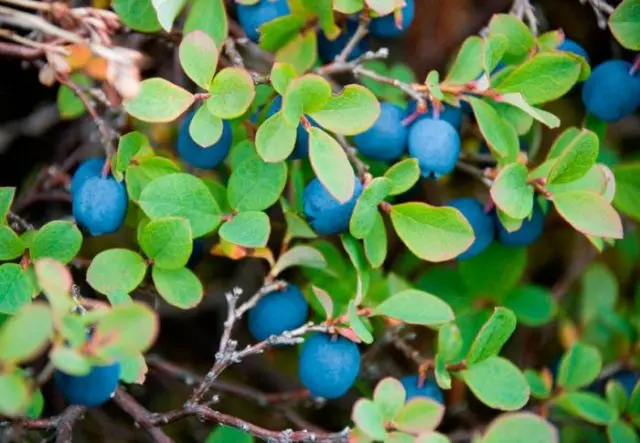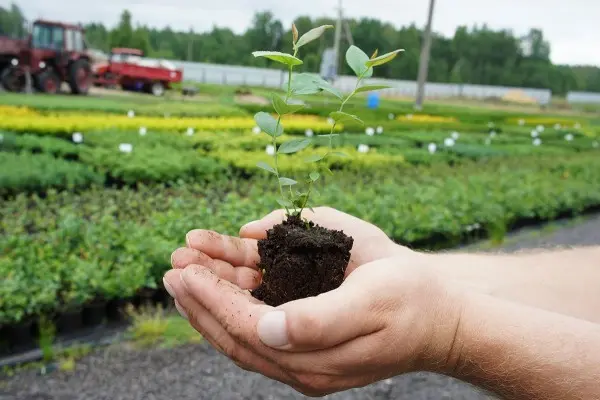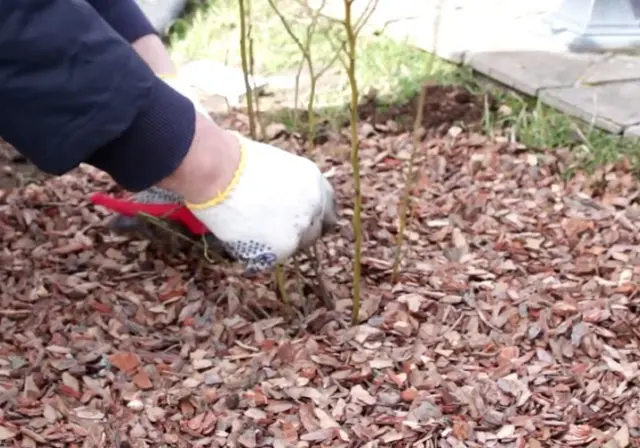Contents
Reproduction of blueberries is possible by generative and vegetative methods. Generative or seed propagation is a complex method used by professional breeders to obtain new varieties. For the propagation of blueberries at home, a vegetative method is used using various parts of the plant.
How garden blueberries reproduce
Propagation of garden blueberries is similar to other berry bushes. But compared to other crops, blueberries take root more difficult. Also, varieties of garden blueberries differ in their ability to shoot, so the amount of planting material from different bushes may vary. With vegetative propagation by layering, cuttings and dividing the bush, all varietal characteristics of the mother plant are preserved.

How to cut blueberries and at what time
To propagate garden blueberries with lignified cuttings, planting material is harvested in early spring or late winter, in regions with a warmer climate. Cutting cuttings is often combined with general pruning of the shrub. The main rule when collecting lignified cuttings is that the mother plant is in a dormant period. To obtain planting material, annual shoots that are well ripened are cut off.
A video on the propagation of garden blueberries with green cuttings shows that planting material is collected in the middle of summer. Harvest time is limited to a few weeks during the dormant period of the plant. Depending on the growing region and the weather conditions of the current season, the collection of green cuttings begins at the end of June. At this time, the first wave of shoot growth is completed, and the next one has not yet begun.
Planting material in the case of green cuttings of blueberries is collected from the growth shoots of the current year or branching shoots.
How to propagate blueberries with woody cuttings
Sliced lignified shoots are tied in bunches. Before planting, they must be stored in a refrigerator or a specially constructed glacier, where the cuttings are left in an alternating layer of snow and sawdust. The temperature during storage should be around +5°C. Cuttings during this period must be periodically inspected to prevent them from drying out or mold.
For propagation of blueberries by cuttings at home, a place is prepared in advance in the greenhouse. An acidic substrate is poured into a separate box. The mixture for planting is prepared from 3 parts of high-moor peat and 1 part of river sand. When planting directly in a greenhouse bed, the soil is removed from it to a depth of 20 cm and replaced with a suitable one for growing heather crops.
Depending on the equipment of the greenhouse, cuttings are planted in the spring one month after they are stored in the refrigerator. From the video on the propagation of blueberries by cuttings, you can see that the prepared shoots are shortened for tall blueberry varieties up to 10-15 cm and for short ones up to 7-10 cm. The lower cut is made obliquely under the bud, the upper one is even, 1,5-2 cm above kidney.
Depending on the expected time spent in the greenhouse, the cuttings are planted in the garden more densely or sparsely according to the scheme 5 by 5 cm or 10 by 10 cm. The cutting is stuck vertically into the soil mixture and watered. To create the necessary microclimate, arcs are installed above the bed and the planting is covered first with plastic wrap, then with any non-woven material. In the greenhouse, it is necessary to maintain a high air temperature in the range of + 26 … + 28 ° С and constant humidity. Watering is carried out by sprinkling.
With the method of propagation of blueberries by lignified cuttings, rooting occurs for about 2 months. At this time, the plants need constant care. The greenhouse is regularly ventilated, maintaining a constant temperature of air and soil without its sudden changes. Seedlings are watered and treated for diseases.
After the cuttings take root, the shelter is removed. Before planting in a permanent place, seedlings are grown for several years. With good care, the results of propagating blueberries by cuttings can be obtained after 2 years.
Reproduction of blueberries with green cuttings

With the method of green cuttings of garden blueberries, planting material is harvested early in the morning to prevent dehydration of the stem. The side shoot is clamped with the thumb and forefinger at the base and cut off with a sharp downward movement so that the shoot has a “heel” – part of the bark from the main branch. Too long a strip of wood is cut with a disinfected sharp knife or secateurs. The length of the cutting should be about 10 cm. The lower leaves are cut off, leaving only a few upper ones, which are shortened to half.
To grow green cuttings, horse peat and rotted coniferous litter are mixed in equal parts. Planting material is placed in the prepared substrate, in the greenhouse. The cuttings are placed in a common planting container or cassettes so that the leaves do not touch each other. When caring for plantings, it is important to maintain high air and soil temperatures. When propagating blueberries with green cuttings, their leaves should always remain moist, for this they carry out frequent spraying or install a fogging system.
In the case of blueberry propagation by green cuttings in a greenhouse, additional shelter is not required in the summer. With proper care, the cuttings take root in 4-6 weeks. In autumn, young plants are covered or transferred to a cool room. In the spring of the next season, the sprouts are transplanted into larger containers for further cultivation.
The survival rate during propagation of blueberries with green cuttings is somewhat lower than with lignified ones. But harvesting green cuttings is easier and does not require storage space during the winter. Lignified cuttings are taken from formation shoots, which are fewer on the bush than branching shoots, from which planting material for green cuttings is taken.
The cutting method is one of the only possible ways to propagate tall blueberry varieties.
How to root a blueberry cutting
Blueberries take root for a long time, so before planting the cuttings, the lower cut is dipped in a special powder that stimulates the formation of roots. For heather crops, which include blueberries, root growth accelerators based on indolylbutyric acid are also used. Under all growing conditions, the average survival rate of sprouts when cutting blueberries is about 50-60%.
How to propagate blueberries by dividing the bush
You can propagate blueberry seedlings by dividing an adult bush. With the method of dividing the bush, the mother plant is completely dug up. From one adult shrub during reproduction, several independent plants are obtained.
The root system of blueberries is superficial, so digging up a bush is easy. After removing the bush from the soil, the earth is shaken off, the roots are inspected. Only a completely healthy plant is suitable for transplantation. Damaged or dry roots are cut off. The bush is divided manually in such a way that on each independent part – the division – there is a well-developed root, more than 5 cm long. 3-4 divisions are usually obtained from an adult bush. After separation, the roots are sprayed with disinfectants, as well as root stimulants.

When propagating by dividing the bush, it is important to prepare a place in advance for transplanting new plants. When planting, the roots are straightened so that they are evenly distributed in different directions, otherwise the plant will not take root.
Reproduction of garden blueberries by layering
Reproduction of blueberries by layering is characterized by a long waiting time and a low yield of planting material. But this method of reproduction does not require special conditions for keeping the seedling, while the plant grows strong and hardy.
For propagation by layering, the lateral shoot of the mother plant is not separated, bent to the soil and covered with an acidic substrate for growing blueberries or sawdust from coniferous trees. During cultivation, upward shoots grow from the place where the buds are located. They are cared for in the same way as an adult bush, maintaining the moisture and acidity of the soil.
Rooting during reproduction by layering occurs after 2-3 years. After the formation of their own roots, new plants are carefully dug up, cut off from the mother shoot with a sharp garden tool and immediately transplanted for further cultivation in a separate place. If the place is not determined, it is permissible to grow blueberries in a container with a suitable substrate.
How to propagate blueberries root shoots
Blueberry basal shoots, which form independent plants near the mother bush, can also serve as planting material. In order to propagate the culture in this way, the ground around a separately growing shoot is dug in. A binding root is found in the soil and cut off with a garden tool. The shoot, together with the rhizome, is dug up and transplanted to a new place or container.
Propagation of garden blueberries by cardinal pruning
A method in which the bush is completely replaced with several new plants. Cut off all shoots in spring. Under the remaining root, a complex mineral fertilizer is applied in a double dosage. Sawdust from coniferous tree species is poured on top. The layer of sawdust should be about 30 cm.
A small greenhouse is installed above the growing place to maintain the necessary humidity and growing temperature, as well as protect young plants from a sharp cold snap. In place of the cut shoots, new ones will soon appear. But the development of its own roots will occur within two years. They are formed above the original root system, in a piled sawdust layer.
After 2 years, young shoots with their own root system are separated from the mother bush and planted separately. With the method of pruning the bush and growing new replacement shoots, the shrub is grown for several more years to obtain the first berries.
Conclusion
Propagation of blueberries is a more complex and lengthy process than that of other berry bushes, and requires experience and skill from the gardener. Rooting occurs within a few months. And the first berries can be collected from the shrub 4-6 years after planting. But the vegetative propagation method is especially suitable for obtaining repeats of rare or liked varieties.









